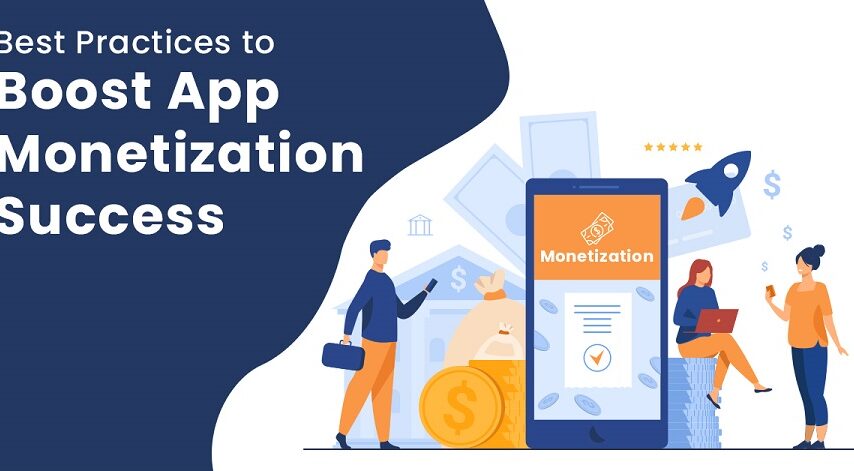Every entrepreneur who thinks of building an app expects to recoup the money, time, and resources invested during the app development process. Monetization models help start-ups and SMBs stay afloat in the niche industry while delivering enormous value to users. However, without implementing a proper monetization strategy, it’s difficult to generate revenue.
Despite following the latest monetization trends, such as in-app ads, interstitial ads, subscriptions, in-app purchases, and others, businesses cannot maximize revenue. There is no bulletproof solution, as different combinations of monetization strategies bring results for one app but not for another. The disproportion in app revenue indicates that best practices are not followed during monetization strategy implementation.
The best practices followed by the leading apps have succeeded in driving high ROI. These practices enable businesses to build revenue with selected monetization strategies.
8 best practices to maximize revenue from app monetization strategies
Ensuring effective results from app monetization strategy is accompanied by the best practices that mobile app development companies always recommend. Go through the best practices that help businesses succeed with massive ROI.
Decide which monetization model fits the best
The app monetization strategy must be well-thought-out when app development starts. As there are different monetization models that businesses can deploy, it’s essential to proactively define which model, such as freemium, paid, in-app purchase, advertisement, or combination of models, to leverage. Nowadays, hybrid monetization is considered a practical model because businesses can be saved from the limitations or weaknesses of one monetization model.
Test the price tag and keep it optimal
Testing the price tags kept for paid applications or in-app purchases is necessary because a high price tag in the initial stage may take the users to the competition. Most users won’t like to make in-app purchases; instead, the loyal fans of the app may go for it. However, ensure the price is minimal as the users feel it’s too low compared to what the app offers under paid installation or the in-app purchase umbrella. For example, WhatsApp kept $0.99 as an annual subscription fee after a year of the app download, but at a later stage, they removed the charges and made the app completely free.
Monitor conversion rate
Conversion data speaks a ton about monetization strategy leverage. It showcases whether the current monetization model is inhibiting users from installing and using the app. For example, when the conversion rate of a paid app is low or high, it enables businesses to know if the premium model is driving users away or if the best content is keeping them hooked on the app.
Monitoring the conversion rate of free apps when they showcase lower conversion indicates the app’s experience or other flaws preventing users from consistently using it. Measuring conversion rate helps balance optimal conversion and best user experience delivery while optimizing monetization strategy implementation.
Adopt the freemium model to some extent
Some businesses think of keeping the freemium model but don’t optimize it moderately, which can make users download the app. It makes users feel it’s not worth enough to spend their valuable time on a useless app. Businesses should work effectively on freemium apps so that they appeal to the users who consistently use the app and make them readily pay to unlock premium features. Smartly using freemium edition enables engaging the target users, and then monetizing through different ways becomes easier.
For example, Mailchimp allows users to send 12,000 emails to 2000 subscribers monthly, but afterward, users need to subscribe to the paid plan. Add value to the freemium version of the app before adding price tags to additional features.
Don’t force users to make in-app purchases
In-app monetization is a popular approach for generating high revenue, but it brings positive outcomes only when a free app delivers value and entices users to go for in-app purchases. Forcing users to make in-app purchases is not good, as it frustrates them and makes them uninstall the app. For example, Subway Surfers allow users to continuously play without buying coins. However, as the users move to higher levels, purchasing items or coins is essential to extend the capacity and play better.
Spend on improving app discovery
With millions of apps on the app store, it’s pretty standard that your app gets lost in the sea of apps. That’s where improving the app’s discoverability is essential to make the users aware of the app and its offerings and reveal how easy it makes users’ lives. Unless the app is not visible to the users, making the users download and earn through distinct ways is implausible. Businesses should keep practicing using ASO tools, consider ad channels, generate positive reviews, and optimize app descriptions to get the app noticed by a larger share of users.
Keep relevant ads only
In-app ads are a famous monetization model that brings high revenue to businesses. But they should be used strategically. For example, display ads related to the products or services that the mobile app refers to. Taking a step ahead, ad content should be relevant in interstitial ads and native ads for ad campaigns. When these ads are intrusive, they interfere with user experience, which is not healthy for app monetization. Ensure the monetization model doesn’t interfere with user experience.
Analytics and data
Researching and analyzing monetization models’ usage helps businesses determine the revenue-generating abilities of the employed models. The analysis provides rich insights into user behavior , preferences, and interests for different monetization models, which further allows optimizing revenue strategy accordingly.
Monetize consistently with research, analysis, and optimization.
The cost of mobile app development pays off when businesses monetize effectively. However, app monetization goes beyond the selection of app monetization models. It first requires following best practices even before the implementation of monetization strategies.
Businesses should invest in user acquisition, user experience, analytics tools, improving app discoverability, price testing, and others to ensure the monetization model improves revenue. It’s an ongoing process that mandates analyzing revenue to identify gaps and optimize strategies that grow revenue by multi-folds.




